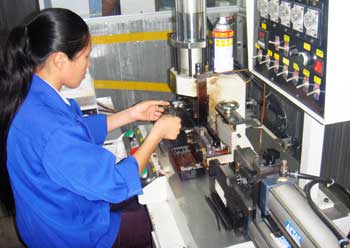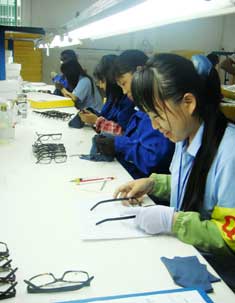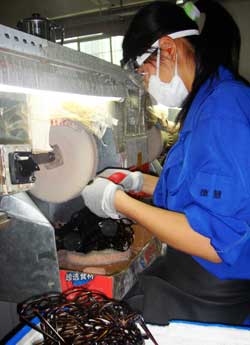Mike Hundert, CEO of REM and Base Curve Eyewear, recently returned from a three-week trip through China. It’s his third visit to China in the past year and this represents his third update on the manufacturing scene there.

Mike Hundert
China, the home of eyewear manufacturing (whether everyone wants to admit that or not) reflects the challenges in the retail eyecare marketplace. When the US Administration announced last September that our economy was more toxic than the Yangtze River the effect on eyewear manufacturing was fast, sharp, brutal, and for some a closing chapter.
Hardest and most immediately hit was the premium sunglass market, those sunglasses sold largely through eyewear dispensaries, department stores, and sun specialty retailers. Factories that had a large proportion of their production dedicated to fashion branded sunglasses felt a drop of more than 30% in their business during the fall and winter. For the most part, it appears factories that predominately depend on moderate and lower cost quality optical frames have done better than those focused on luxury sunglasses and high end frames.
Many factories, including hundreds of sub-contractors closed their doors since last fall. Others have laid off thousands of workers. One of the largest eyewear factories, with about 11,000 workers is now employing less than 9,000. Another with 2000 workers has cut its work force by 25%. At some smaller manufacturers the labor cuts were of a higher percentage. Manufacturers across segments have slowed their implementation of new costly labor laws that went into effect in January 2008. The government, to avoid adding to the plight of business, hesitates to enforce those laws with any vigor.
Like all things in China, “that was then, and this is now.” Factory owners tell me consistently that the bottom seemed to have been hit around March, perhaps not coincidentally the bottom of the stock market (so far). They believe companies that defensively held back orders found their inventories low and replenishment necessary. Whether that is a temporary catching up to over-anxious pessimism or a positive sustainable change remains to be seen. Meanwhile, it also means that companies (like REM) have cleaned up their inventory and become leaner healthier firms. That’s provided the town-turn is truly over, a hope that is not necessarily a fact.
 |
|
Shooting wire core into temple |
I spent three weeks in China this spring, traveling to five cities to visit 15 factories and two customers. Starting in Hong Kong, we crossed the border ad Shenzhen and worked with our long established factories there and in neighboring Dongguan and Guangzhou. We flew to Nanchaing, deep in the heart of historic Jaingzi Provice. A pleasant train five-hour train ride and stopover in Shanghai preceded a flight to Wenzhou for a final few days at factories.
The mood, while serious and somber is now far more positive than it was early this year. This is especially true in areas that specialize in the value segment and in a place like Ying Tan (bring Power Bars and an interpreter), where local government has created an industrial park to lure manufacturers from elsewhere to set up shop with the promise of lower cost labor and favorable government incentives.
Manufacturing of eyewear is complex, requiring a feeder network of suppliers for such things as hinges, nose pads, acetate, sophisticated components, etc. So, for the Ying Tan experiment to work it requires attracting all sorts of companies to transplant to this town of about one million people located deep in the heart of China. The concept was just beginning to take hold with more than two dozen companies opened in the industrial park prior to last September’s meltdown. When exports hit the wall companies considering the move or the opening of a satellite factory put their plans on hold.
Meanwhile, in the coastal city of Wenzhou, once the low-cost eyewear manufacturing hub, the quality of its output has greatly improved as has its global approach and outreach. When I first started dealing there in 1999 a factory owner couldn’t get a visa to leave the country. He couldn’t visit me in the US, despite my letters of invitation. And he couldn’t even visit me in Hong Kong. We had to meet just over the border from Hong Kong in Shenzhen. Today, that’s all changed. Chinese entrepreneurs are able and encouraged to travel the world in search of orders. In fact, in the recent Chinese government stimulus package, there is a pool of money for those manufacturers to tap for covering the cost of exhibiting at international trade shows. Business in this part of China appears stable and growing.
 |
| Quality control |
As for all those worker rights initiatives that became law in January 2008, many local governments are backing off from strict enforcement. This is a result of factories closing under the weight of those requirements clashing with the downturn in global demand. But those costly new stipulations are not going away. And the cost of eyewear production is not coming down, although it has stabilized. That leaves all of us with the challenge of finding more efficie
|
|
|
Hand polishing |
After these recent three weeks in China I continue to be impressed with the evolution of business development in the country. Sure, weak players have been toppled by current events. But savvy and capable operators, just like in all segments of the business, find ways to navigate through the troubled waters with eyes clearly focused on the future. I visit China two to three times each year. And with every visit it is clear that business development, global sophistication, expertise and ingenuity, devotion to design and to quality continues to spin in positive directions.
This journey also proves to me the importance of continuing to explore, to better understand the landscape as it evolves. Through broader and deeper knowledge of our industry’s complex supply chain one gets a deeper appreciation for all its intricacies and is more capable of creating innovative solutions. Through the relationships one builds at all levels of the supply-chain we are able to chart and enjoy a better future.
And while the food has even improved by our western standards, do remember to bring your Power Bars.
Mike Hundert’s email is [email protected]. Video of his recent China journey is posted at www.remeyewear.com/press_media.html












